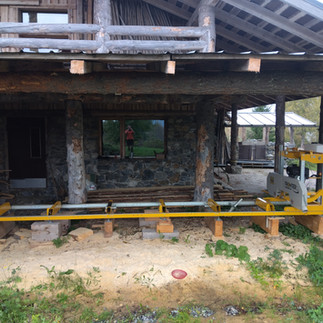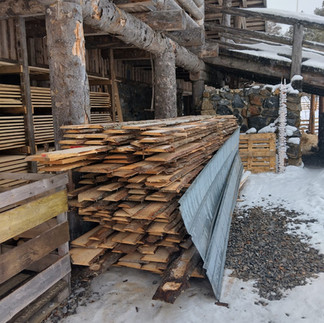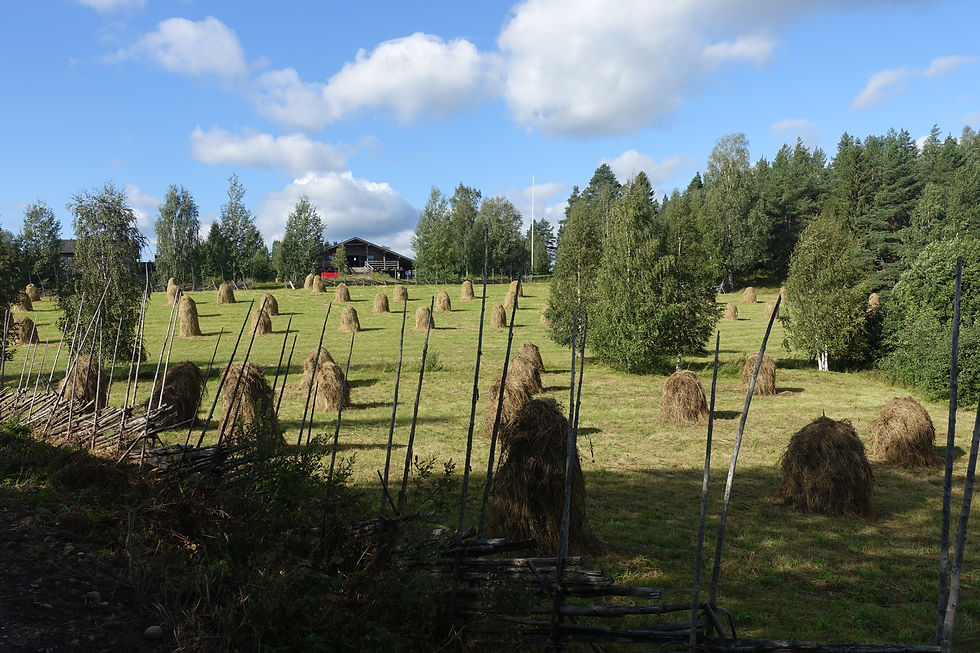Moon wood – From tree to board
- Patrick Vogel

- Jul 6
- 4 min read
For centuries, foresters and woodworkers have believed that the timing of felling is crucial for the quality of the wood. So-called moonwood, in particular, has a reputation for being more durable, stable, and less susceptible to pests.
We want to show you what it means to harvest, transport, saw, and use moon wood yourself. We'll show you the difficulties involved and the freedom we have.
What is moon wood
Moonwood is wood that is harvested during specific phases of the moon. Usually during the waning phases of the moon in winter. This is very important.
Traditionally it is said:
When the moon is waning, less sap flows into the tree.
The wood dries better and cracks and warps less.
It becomes more resistant to fungi, insects and even fire
These traditions are ancient and partly scientifically proven.
Many carpenters, instrument makers, and natural construction companies swear by it, and we also try to work with it as much as possible. Moon wood also sells for up to 30% more than conventionally harvested wood.
A process lasting months.
In winter, life in northern North Karelia slows down. Temperatures drop to as low as -30 degrees Celsius between January and March. The snow lies waist-deep, and moving through the deep snow without snowshoes is a real ordeal. It's precisely during this time that moonwood is harvested. Proper equipment is essential, not only for safety during logging, but also for a gentle and efficient approach.
Our region is predominantly flat, so you might think felling trees isn't a big challenge. But the ground is often extremely rocky, and the roots are only shallow in the soil. This is one of the reasons why many trees here aren't upright, and in the worst case, loose roots determine the direction they fall. Since we're not professional foresters and still have a lot to learn, it sometimes happens that a tree doesn't fall quite as planned.
This happened in our second year when a tree fell on the main power line. Fortunately, no one was hurt. After a bit of a shock, a bent chainsaw blade, and a bruised ego, we can now smile about it a little. This incident showed us that despite all precautions, something can always happen, and we have the utmost respect for people who do this every day.
The trees, mainly pines, spruces and birches, are felled shortly before the new moon. If the weather doesn't cooperate, you have to wait until the next new moon, for better or for worse. Since the forests are inaccessible in winter without large machinery, we leave the trees until spring. The branches remain on the trunk so that any remaining water can evaporate through the needles before they die. The fallen needles also return nutrients evenly to the soil. This also means that the trunk is not in constant contact with the ground and can dry out more easily.
We use moon wood because we want to see what effect it has and because it only means a small additional effort for us to get a higher quality product.
We mainly need the wood for the renovation of the Riihiniemi cottage, the greenhouse, and fences. We also regularly have smaller construction projects, such as the outdoor area including a rabbit hutch, the boathouse and a sauna on the lakeshore, countless bee hives, and a chicken coop that will be built on a trailer. You can follow the construction progress of the cottage here . We purchased a mobile sawmill to process the logs. You can read why we did this despite the high purchase price here .
It is not until late April or May that the snow has melted enough for us to pull the tree trunks out with the small Avant and bring them back to the farm. We use a converted manure fork to clamp the logs. This requires particular care to avoid unnecessary damage to the surface of the logs. Sometimes a neighbor helps us with the transport with his timber trailer.
This year, we were able to collect wood in March and April and cut it into boards for the interior and exterior walls, as well as the floor of the Mökki. After cutting, the wood for this project has to dry. We store it on a rack in a covered passageway so that the wood can air-dry after 2-3 months. Then it will be planed and installed.
This entire process, from tree to board, often takes months and involves a tremendous amount of work. To be honest, we somewhat underestimated the entire process, including felling, transporting, sawing, planing, milling, and more. Not only the time involved, but also the fact that it's sometimes difficult to achieve the necessary precision with our secondhand hobby tools. We've often stood in front of the lumber shelf at the hardware store and wondered how easy it would be if we could simply buy the wood we needed and use it immediately.
Despite everything, it's a nice feeling to know that all the wood used was felled by hand, carefully transported, cut to size without significant waste, planed with patience, and then lovingly installed. This also gives us the freedom to cut any dimensions we need without having to rely on external suppliers. Knowing how much work goes into this process motivates us to handle the material with care. We think twice about how to cut a piece of wood to minimize waste and try to reuse the leftover pieces, even if they "only" end up in the stove.
Since we haven't yet completed our first projects with moon wood, or at least haven't finished them for a long time, we unfortunately can't say whether we've noticed any effect or not. However, we'd like to keep you updated.
Let us know in the comments what you think, what your experiences with moon wood have been, and whether building with moon wood would be an option for you.
Every heart, every comment, and every message you leave warms our hearts and keeps us going. Thank you for sharing this journey with us. We’re so grateful you’re here.

















Comments